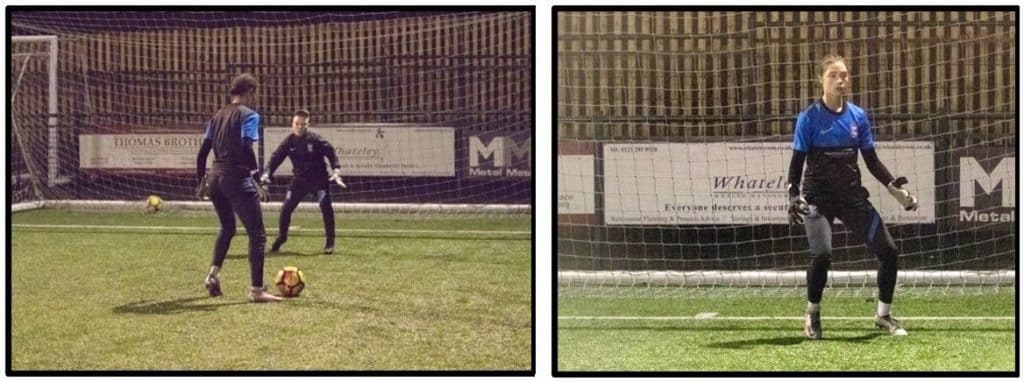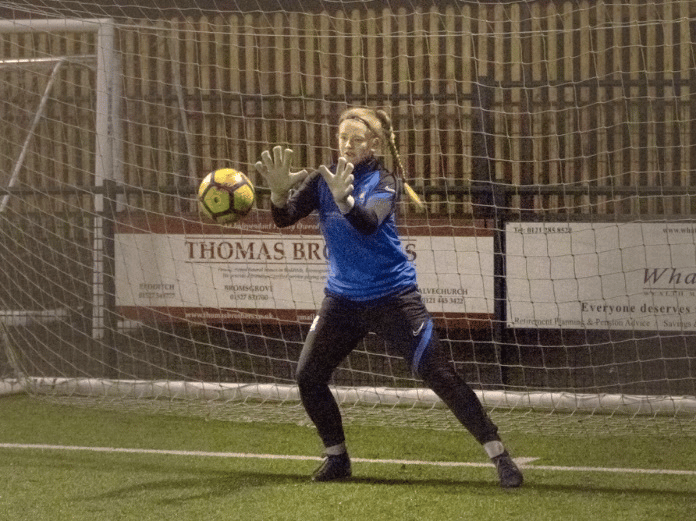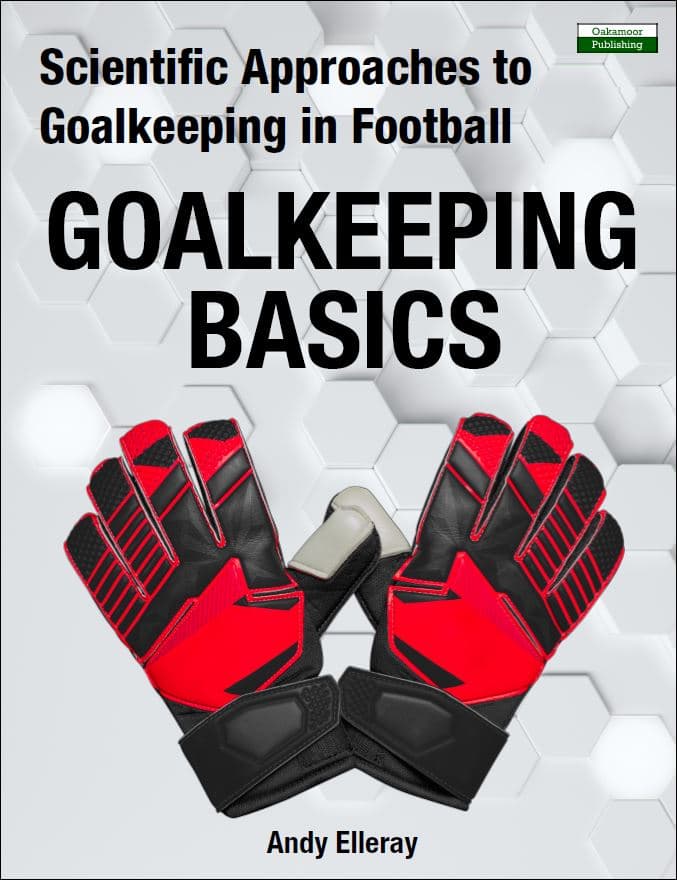An excerpt from Andy Elleray’s book – Goalkeeping Basics.
Andy is the author of numerous top-notch Goalkeeping Books.
Technical & Physical Foundations
Technical and physical goalkeeping have been grouped together because they go hand-in-hand. Without physical literacy in place to perform specific goalkeeping actions, the technical prowess of the goalkeeper will ultimately be limited.
A goalkeeper must consider the distance between themselves and the ball at all times. This informs how best to deal with the situation in front of them. This will be a frequent train of thought throughout the book.
It’s really useful to build tactical points into technical practices as the positioning of the keeper can often dictate how they approach a save. For example, if the keeper is in a poor position to defend the goal, they may have to perform an action that is harder than it needs to be.
There are a great deal of goalkeeping actions, approaches, and philosophies all over the world. Within these upcoming sections, common practice and conventional goalkeeping will be analysed (although that’s not to say that the goalkeeper should be limited to just these types of saves). The game is ever-changing and evolving, and the goalkeeper must follow suit in how they can best defend their goal and deny the opposition.
The first area that will be analysed will be the concept of the set (or at times labelled the ready position). Let’s get started.
Set Positions
Historically, the set position will be the first thing taught by a coach to a goalkeeper – regardless of age or ability. There is a general misconception that there is one ‘standard’ or ‘traditionally taught’ set position. The truth is there isn’t. There isn’t a one-size-fits-all approach as the set position is very much an individual stance and moulds organically as time goes by during a footballer’s career.
Attackers are taught to try to catch the goalkeeper who is not set, or to finish early to try and catch the goalkeeper either moving, or on their heels. The holy grail for a goalkeeper is to analyse when to set, in accordance with the cues in front of them; they want to be in a balanced body position to make informed decisions on how to respond to the football.
Ultimately, the objective of the set position is to get the goalkeeper in a physically ready state, in order to optimize their movement.
Factors that will affect a set position consist of:
- Height – leg, arm, and torso makeup
- Weight
- Age – Maturation
- Movement patterns and general biomechanics
- Genetics
- Position of the ball (distance and angle away from the goal)
- Surface played on
- The country where you ply your football – trends and coaching methodologies
Often a low set position (with the goalkeeper crouched) is taught. But a player who is too crouched and low in their stance will inhibit their movement; by lowering the set position, the lower leg muscles are already engaged, so vertical movement becomes impeded.
The following images show a couple of examples of set positions. Note the right-hand image; it follows the commonplace principles of:
- Feet being a shoulder-width apart
- Weight on the front part of the feet
- Hands out
- Head over toes

The set position is the first part of what’s called Engage/Prepare/Execute.
From a coaching perspective, the goalkeeper needs to be comfortable and natural in their stance so that they don’t think too much.
Next time you watch a match, have a look at the goalkeepers’ set positions. Some set low and wide, some set tall and narrow, some change depending on different ball ranges and the angle of shots. Some will even ‘jump’ into their set position. My main point is that the variations are endless, and the set position needs to work (for the most part) for each player. Do not coach a goalkeeper into a set position that is unnatural for them. Habits that impede and affect movement are a key coaching consideration, of course, but issues can be ironed out over time.
The vital body part is the head (although, of course, the hands are pretty useful too!). But from a technical and physical viewpoint, the closer the keeper can get their head to the ball, during any action, the more chance they have of being in the optimum physical position to execute the save they need to – making the most appropriate and effective action they can at that moment.
Take a tennis player as an example. When they are looking to return the ball, they don’t use their arms solely to try and reach for the ball; they get their head as close to the ball as possible, staying compact to generate the necessary power to win the point. Batting in cricket follows the same concept in terms of getting the head as close to the ball as possible, to remain in total control of actions.
Hand Saves: Catching
What
Being able to catch a football should be a goalkeeper’s bread and butter. But in many situations, this skill – which it is – gets overlooked and under-coached for various reasons. They include positional aims, football trends, and different training methods.
When
Bearing the above paragraph in mind, every single shot or cross cannot be caught! This section will look to showcase different examples of what catching looks like in different situations within the goal.
How
The next image shows the goalkeeper preparing herself with the intention of catching the ball. Catching the ball is a mentality.

The key point here is that if a goalkeeper is looking to catch a ball, their hand shapes and mentality change due to the fact that body positioning changes.
If the intention is to deflect/push the ball away – the above elements will be modified.
Not all attempts to catch the ball will succeed. Factors such as weather conditions, pace/spin on the ball, direction of the strike on goal, hand size (in relation to the ball), and a goalkeeper’s individual style come into play at all levels of the game. But, being able to secure the ball gives the team a chance to retain the ball and regroup. From experience, managers celebrate a goalkeeper that looks to secure the ball (when possible, of course)! Frustrations creep in when they think the goalkeeper should be catching a ball, but they deal with it in a different way.
Discussions around this topic are probably for another book! But the premise here is that if the goalkeeper can secure the ball, their team is in possession and there’s no immediate danger of the opposition scoring.
The hands are an extension of the body and, therefore, a skill that can be trained; the key is to keep the ball off the grass where possible or to kill the ball dead so the ball stays in the keeper’s vicinity.
* * * * *
This was an excerpt from Goalkeeping Basics by Andy Elleray.
In the rest of the book…
Technical & Physical Foundations
Set Positions
Hand Saves: Catching
Hand Saves: Scoop Save
Hand Saves: Cup/Basket Save
Hand Saves: ‘W’ Save
Not catching the ball
Hand Saves: Repel Save
Hand Saves: Get Away Save
Hand Saves: One-Step Dive
Hand Saves: Negative Step Dive
Hand Saves: Shift and Dive
Hand Saves: Top Hand Save/Dive
Hand Saves: Bottom Hand Save/Dive
Hand Saves: Tip-Over
Hand Saves: Deflect Away
Hand Saves: Low/Mid/High Dive
1v1 Saves
1v1: Smother
1v1: Close Block
1v1: Spread Save
1v1: Star Spread
Leg Saves
Leg Saves: Standard
Leg Saves: Kick-Through
Leg Saves: Splits Save
Crossing & Aerial Play
Crossing & Aerial Play: The Claim
Crossing & Aerial Play: The Cut Back
Crossing & Aerial Play: One-Handed Punch
Crossing & Aerial Play: Two-Handed Punch
Crossing & Aerial Play: Push Away
Crossing & Aerial Play: Flying Punch
Super Strength Sessions
Tactical Foundations
In Possession
Factors to Consider
Coaching Approaches
Goalkeeping Ball Mastery
Out of Possession/In Transition
Psychological Foundations
The Life of a Goalkeeper…
Confidence
Decision-Making
Communication
Dealing with Mistakes
Summary


